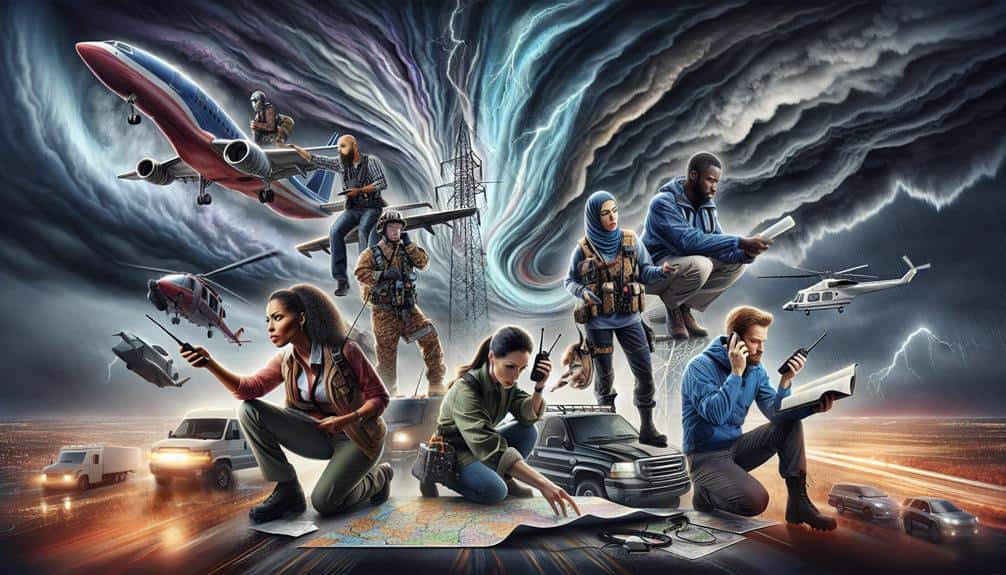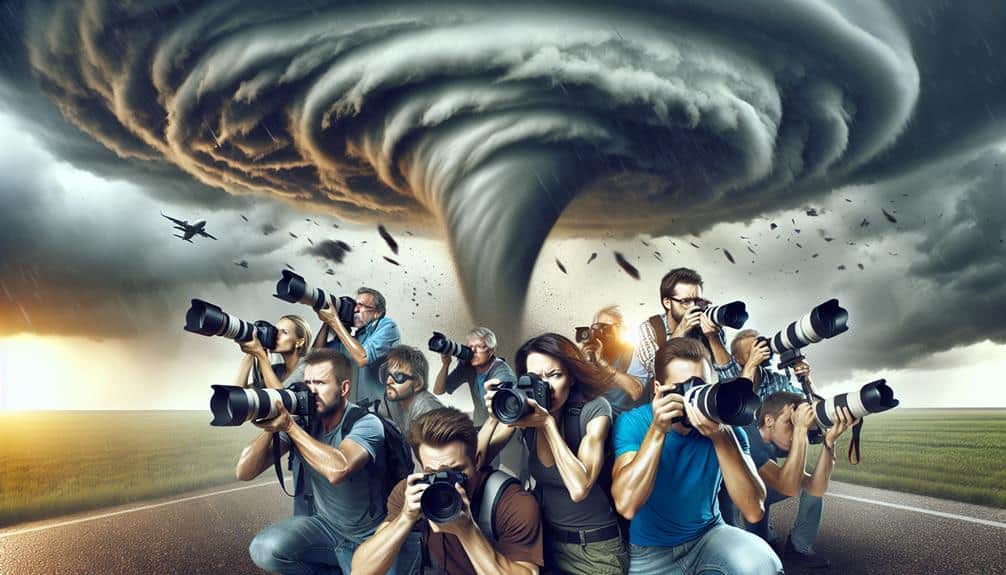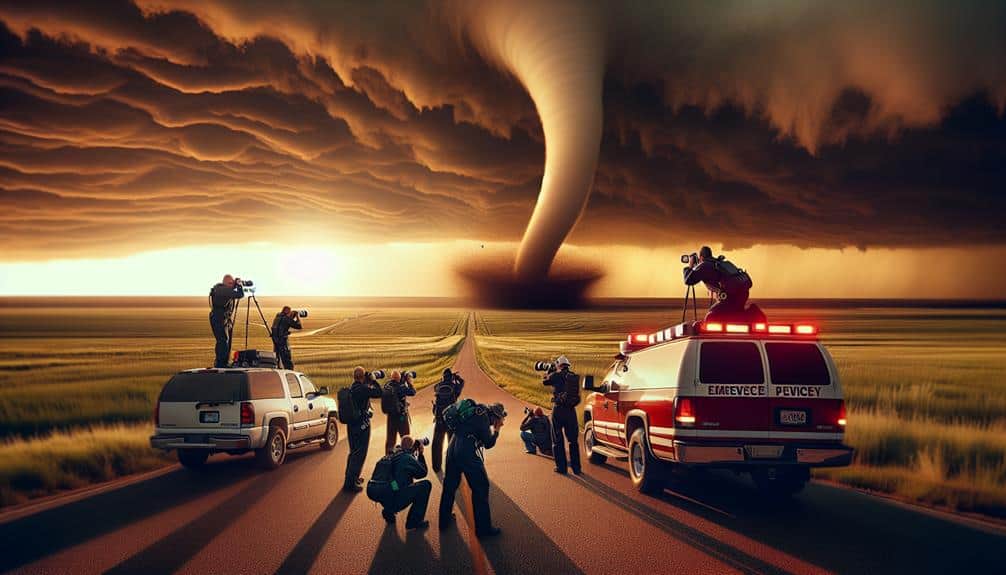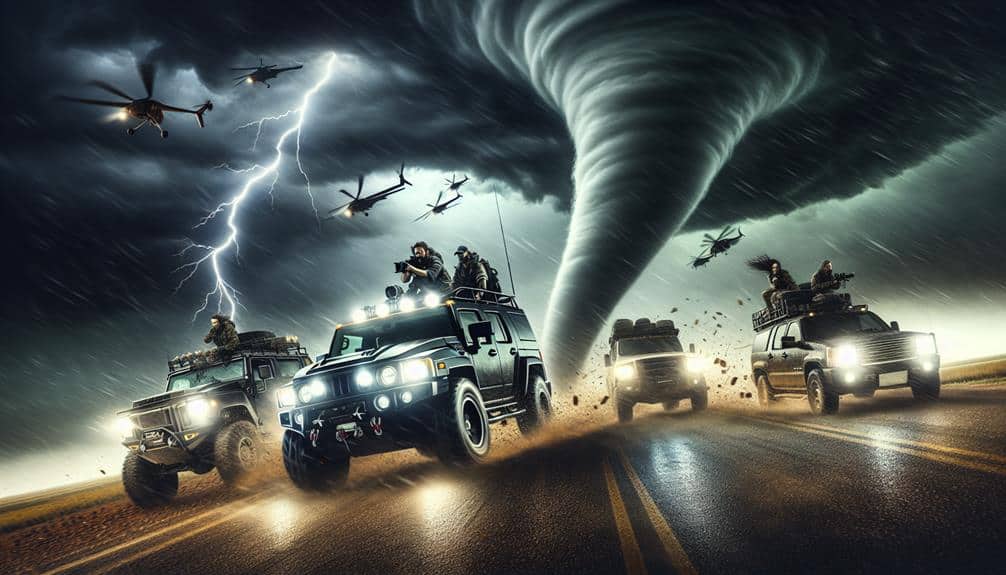We prioritize high-resolution radar systems, GPS-enabled devices, and advanced weather forecasting tools like AWIPS and WRF models to guarantee our storm chaser expeditions are accurate and safe. Utilizing Doppler radar and satellite imagery aids in real-time meteorological assessments, while anemometers and emergency supplies enhance field readiness. Our safety protocols mandate encrypted communication via radios and GPS tracking. Defined roles like Lead Meteorologist and Media Specialist guarantee efficient operations. Essential photography gear, including weather-resistant cameras and HDR settings, captures the events precisely. Proper preparation involves intricate gear and data-focused methodologies, important for any successful expedition. Discover more about optimizing these techniques next.
Key Points
- Equip with high-resolution radar systems, GPS-enabled devices, and emergency supplies for safety and navigation.
- Utilize cutting-edge weather forecasting tools and apps, including satellite imagery and Doppler radar, for accurate meteorological data.
- Follow strict safety protocols with constant encrypted communication and real-time data sharing for risk assessment.
- Define and coordinate team roles effectively, ensuring clear communication and operational efficiency.
Essential Gear Checklist
When preparing for storm chaser expeditions, we need to ensure our necessary gear checklist includes high-resolution radar systems, anemometers, and GPS-enabled devices for accurate tracking and data collection. These technologies provide real-time atmospheric data vital for understanding storm dynamics and securing our safety.
Next, let's talk emergency supplies. Packing tips are essential: we should include first-aid kits, thermal blankets, and water purification tablets. These items guarantee we're prepared for unforeseen circumstances, enhancing our resilience in remote locations. Each team member must also carry personal survival gear, including flashlights and multi-tools.
Vehicle maintenance is another essential aspect. Our vehicles must undergo rigorous pre-expedition checks, focusing on tire integrity, fluid levels, and battery health. Robust vehicles are our lifeline, and any mechanical failure could compromise our mission and safety. We should also carry spare parts and tools for on-the-go repairs.
Effective navigation skills are necessary. Compasses, detailed maps, and backup GPS devices enable us to navigate treacherous terrains confidently. Mastery of topographical maps and the ability to interpret digital navigation data will help us avoid hazards and optimize our storm-chasing routes. This meticulous preparation empowers us to chase storms with precision and freedom.
Weather Forecasting Tools
How do we ensure that our storm chaser expeditions are informed by the most accurate meteorological data available? It starts with leveraging cutting-edge weather forecasting tools.
We rely heavily on satellite imagery to provide us with real-time visual data on cloud formations, storm systems, and atmospheric conditions. These high-resolution images allow us to track storm development with pinpoint accuracy, ensuring we're always one step ahead.
Radar analysis is another essential component in our toolkit. Doppler radar, for instance, offers us detailed information on precipitation intensity, storm rotation, and wind velocity. By analyzing radar data, we can detect tornadoes, severe thunderstorms, and other hazardous weather phenomena early. This information is vital for determining the most promising locations for intercepting storms.
Additionally, we utilize numerical weather prediction models that integrate data from satellite and radar sources. These models generate forecasts that guide our decisions on when and where to deploy. Tools like the Advanced Weather Interactive Processing System (AWIPS) and the Weather Research and Forecasting (WRF) model provide us with the computational power to analyze vast amounts of meteorological data.
Safety Protocols
Safeguarding our team's safety during storm chaser expeditions mandates strict adherence to established safety protocols, utilizing real-time meteorological data and ground-based observational tactics. Our main focus is conducting thorough risk assessment before and during the chase. We analyze synoptic charts, Doppler radar outputs, and satellite imagery to determine potential hazards. We must be skilled in interpreting these data sets to predict storm trajectories accurately.
Emergency procedures are crucial. Each team member is trained in rapid response maneuvers, including evacuation protocols and first aid. We maintain constant communication via multi-channel radios and GPS tracking devices to ensure our positions are always known. Our vehicles are equipped with emergency kits containing medical supplies, tools for vehicle repairs, and non-perishable food items.
We use mobile weather stations to relay real-time atmospheric conditions, enabling dynamic risk assessments. Our decision-making process relies on the integration of mesoscale models and empirical observations.
Best Tracking Apps
Harnessing cutting-edge tracking apps boosts our ability to monitor storm developments in real-time, complementing our rigorous safety protocols. By integrating state-of-the-art technology, we guarantee access to real-time updates and notifications, crucial for timely decision-making.
For storm chasers, top-notch apps include RadarScope, Storm Shield, and MyRadar. These applications provide high-definition radar data, super-resolution reflectivity, and velocity imagery, vital for predicting storm paths and intensities.
RadarScope offers Level 3 radar data, enabling us to analyze storm structures with accuracy. With its lightning data and severe weather alerts, we can proactively inform emergency contacts.
Storm Shield, conversely, delivers localized weather alerts, ensuring we receive ultra-local notifications about tornado warnings, hail, and severe thunderstorms. It also allows us to share our location and emergency contacts seamlessly, strengthening our safety net.
MyRadar stands out with its real-time updates and advanced layers, including storm cell tracking and future radar predictions. By utilizing these robust tracking tools, we maintain situational awareness and mitigate risks effectively.
Furthermore, the thorough integration of these apps into our daily operations ensures we stay ahead of evolving weather patterns, safeguarding our expedition's success and our collective freedom to chase the storm.
Team Coordination

In our storm chaser expeditions, we must establish clear roles and responsibilities to optimize operational efficiency and minimize risk.
We'll deploy real-time communication strategies using encrypted radio frequencies and satellite uplinks to guarantee seamless data transmission.
Roles and Responsibilities
Effective storm chaser expeditions demand carefully defined roles and responsibilities, enabling seamless team coordination and operational efficiency. For us to carry out successful missions, we need to integrate safety measures and communication strategies into our operational framework.
Each team member must understand their specific duties to maintain situational awareness and minimize risks.
Lead Meteorologist:
Analyzes weather data, forecasts storm paths, and communicates real-time updates to the team.
Vehicle Operator:
Responsible for safe navigation, ensuring the team can position themselves efficiently while adhering to safety protocols.
Media Specialist:
Focused on capturing moments, including high-resolution photos and videos, and documenting data for post-analysis.
These roles are essential for effective team coordination. The lead meteorologist's predictive insights allow the vehicle operator to make informed decisions about positioning. This coordination ensures that the media specialist can focus on capturing moments without distraction.
Safety measures are paramount; our communication strategies must be clear and concise, utilizing both verbal and non-verbal signals. Each role interconnects, creating a robust system that maximizes data collection and minimizes risk.
This precise orchestration allows us to chase freedom in the heart of the storm, capturing its raw power and beauty.
Communication Strategies
Our real-time communication strategies hinge on utilizing encrypted radio frequencies and satellite-based systems to guarantee seamless data transmission and situational awareness. We'll employ advanced radio communication protocols, safeguarding our team stays connected regardless of terrestrial network failures.
Utilizing VHF/UHF channels, we maintain robust line-of-sight communication, critical for coordinating rapid movements and relaying meteorological data.
Satellite phones are indispensable for long-range communication, providing a reliable backup when cellular networks falter. These devices facilitate group messaging, enabling us to disseminate critical updates instantaneously.
We prioritize encryption on all channels to prevent unauthorized access and maintain operational security.
Our strategy includes a thorough emergency contacts list, pre-programmed into both radio and satellite systems. This ensures immediate access to first responders and local authorities when needed.
Integrating GPS modules with our communication tools allows real-time tracking of team members, enhancing situational awareness and safety.
We also implement a hierarchical communication structure. Lead chasers disseminate information to sub-teams via a centralized command hub. This minimizes confusion and maintains a clear chain of command.
Capturing the Event
We must prioritize our essential photography gear, ensuring redundancy with high-capacity memory cards and fully charged lithium-ion batteries.
Employing best camera techniques, we'll utilize high dynamic range (HDR) settings and fast shutter speeds to capture the tempest's details.
Data on sensor sensitivity and ISO performance will guide us in optimizing image clarity despite low light conditions.
Essential Photography Gear
To capture high-quality storm photographs, you'll need a DSLR or mirrorless camera with a fast shutter speed, a wide dynamic range, and weather-resistant features. These cameras excel in capturing the intricate details of storm formations while withstanding harsh conditions.
Selecting the right lens is essential. Wide-angle lenses (16-35mm) allow us to capture expansive skies and storm structures, while telephoto lenses (70-200mm) are ideal for isolating specific elements like lightning. Lens selection directly impacts the final image composition and detail.
Adjusting camera settings is equally important. We should set our cameras to manual mode to control shutter speed, aperture, and ISO. A fast shutter speed (1/1000s or higher) is necessary for freezing motion, while a low ISO (100-400) minimizes noise, crucial in low-light conditions.
Using a sturdy tripod is necessary in variable lighting conditions. It stabilizes the camera, allowing us to use slower shutter speeds without compromising image sharpness.
Key gear includes:
- Weather-Resistant Camera Body: Ensures durability in extreme environments.
- Wide and Telephoto Lenses: Versatile for different storm photography needs.
Best Camera Techniques
Mastering advanced camera techniques is vital for capturing the sheer power and dynamic movement of storm events effectively. To achieve high-quality shots, we need to focus on both lighting tips and composition techniques.
First, let's address lighting. Storm photography often involves low-light conditions, so utilizing a wide aperture (f/2.8 or lower) allows maximum light intake. Pair this with a high ISO setting—though not too high to avoid noise—ideally between 800 and 1600. Use a tripod to counteract longer exposure times, ensuring sharpness in tumultuous conditions.
Composition techniques are equally essential. Employ the rule of thirds to place key storm elements—like lightning strikes or tornado funnels—along the intersecting lines for balanced and engaging visuals. Leading lines, such as roads or fence lines, can guide viewers' eyes towards the storm's core. When framing the shot, include foreground elements like trees or buildings to provide a sense of scale.
Additionally, consider bracketing exposures to capture the full dynamic range, especially when dealing with lightning. Burst mode is invaluable for capturing rapid sequences and unpredictable movements.
Frequently Asked Questions
How Do I Mentally Prepare for the Intensity of Storm Chasing?
We can mentally prepare for the intensity of storm chasing by utilizing visualization techniques to anticipate scenarios and engage our emotional support network to mitigate stress. This approach enhances cognitive resilience and guarantees psychological readiness for extreme conditions.
What Is the Best Time of Year for Storm Chasing?
Imagine exploring a labyrinth; that's spring for storm chasers. We prioritize safety precautions and analyze weather patterns. Spring's volatile mix of warm and cold fronts maximizes tornado potential, making it the prime season for chasing.
How Do I Manage Stress and Anxiety During a Storm Chase?
During a storm chase, we manage stress and anxiety by employing breathing techniques and mindfulness practices. Effective stress management involves integrating relaxation techniques like deep breathing and progressive muscle relaxation to maintain focus and composure under pressure.
Are There Any Recommended First Aid Skills for Storm Chasers?
We understand, first aid might seem excessive, but emergency response and basic medical training are essential. Knowing CPR, wound management, and how to use an AED guarantees we're prepared for any scenario, maximizing our freedom to chase.
What Should I Do if I Encounter Wildlife During a Chase?
When we encounter wildlife during a chase, we prioritize safety by understanding animal behavior and taking necessary precautions. We maintain distance, avoid sudden movements, and use deterrent tools if needed to guarantee minimal disruption and risk.


